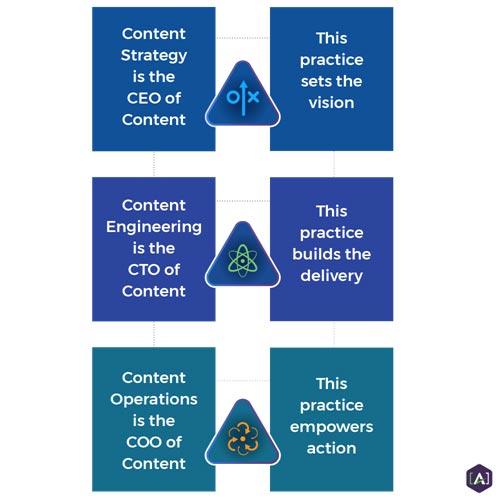Everything that relates to
how we structure and communicate knowledge is changing, along with how that knowledge is consumed and used by humans and machines. [A] proposes a new solution: form a chartered Content Services Organization (CSO) and empower it with durable leadership in the form of three major practices: Content Strategy, Content Engineering, and Content Operations.
As indicated in the figure below, each of these three practices has a guiding role that parallels stakeholders within corporate executive ranks.
Content Strategy provides the who, what, when and why of content, while Content Engineering provides the how and Content Operations provides the where.

Content Engineering Is Key To The Content Orchestration Triumvirate
A new bridge between stakeholders and developers must exist during planning and execution. Enter Content Engineering.
T

he content engineer helps orchestrate the complex tools (musical instruments) and content (sheet music) to achieve a harmonious result (music played in key).
Content and data assets need to be empowered to move seamlessly across organizational silos, Web services, search tools, CRM, CRP, and CEM platforms. Content must be like electricity, moving and transforming to power organizations.
The practice of Content Engineering gives organizations increased strategic alignment and impact across publishing, and improves the overall effectiveness of the spend on assets that can be multi-purpose across usage scenarios. Engineered content assets can be used in many places at once, related, discovered, and used to deliver value at the fastest possible throughput. But, for many organizations today, content is more like a rock: chiseled and placed in some wall like a brick, never to be moved.
Together, content strategists and engineers should be tireless advocates for the transformation of documents into reusable, structured content components connected by common semantics. In other words, these practices work in concert towards intelligence across all content domains.
Content Strategy
Orchestrates the customer experience and editorial approach. It also works on the overall process and the guiding structural standards in collaboration with engineering. Content Strategy designs and curates the targeted content interactions:
- What content is resonating with our customers?
- What is our segmentation strategy?
- Which content maps to which part of the customer journey and market conversations?
- What do we need to publish to meet market needs?

Content Engineering
Encompasses process and structure governed jointly with Content Strategy to enable the original plan for publication. Engineering ensures the ‘how’ of content delivery is possible with integrated, consistent schemas across content technology systems (planning, authoring, management, publishing) with as low friction as possible through all stages of the content lifecycle.
Working on the systems and standards needed to frictionlessly author structured omnipurpose content, tagged and annotated with controlled semantics, and available through the content supply chain to delivery endpoints that produce customer experiences across channels.

Content Operations
Is a management activity that deploys, operates, monitors, and evaluates the content lifecycle and supporting content ecosystem as they are used to realize and optimize the content experience. Content Operations administers analytics programs and reporting, quality assurance, and alignment between the content set’s semantics and structure standards and the actual content in production.
Being the stakeholder who pulls so much together, Content Operations is uniquely positioned to oversee the quality and analytics across the entire content lifecycle, and ensure all workflow processes (including localization, accessibility, SEO, legal) perform their functions smoothly in concert with the content production teams.

[A] provides services and consulting in
Content Operations,
Content Strategy, and
Content Engineering.
Contact Us for a Free Consultation.